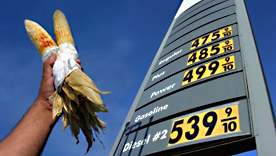- MENU
- HOME
- SEARCH
- WORLD
- MAIN
- AFRICA
- ASIA
- BALKANS
- EUROPE
- LATIN AMERICA
- MIDDLE EAST
- United Kingdom
- United States
- Argentina
- Australia
- Austria
- Benelux
- Brazil
- Canada
- China
- France
- Germany
- Greece
- Hungary
- India
- Indonesia
- Ireland
- Israel
- Italy
- Japan
- Korea
- Mexico
- New Zealand
- Pakistan
- Philippines
- Poland
- Russia
- South Africa
- Spain
- Taiwan
- Turkey
- USA
- BUSINESS
- WEALTH
- STOCKS
- TECH
- HEALTH
- LIFESTYLE
- ENTERTAINMENT
- SPORTS
- RSS
- iHaveNet.com: Autos
By Luigi Fraschini

If you think gasoline prices have skyrocketed recently -- and they have -- you should take a look at the price of corn. It has more than doubled over the last 10 months, far outstripping the pace of gasoline price increases. Why should you care about the price of corn any more than you care about the cost of tea in China? You may not know it, but there is a corn-derived product -- ethanol -- in the fuel that's sitting in your gas tank right now. Not only that, but the federal government also has ambitious plans for the increased use of ethanol -- again, mostly corn-based -- in our fuel's future, and it is backing that policy by a series of subsidies that are designed to promote the use of ethanol.
Now, a report from the Energy Policy Research Foundation Inc. (EPRINC) throws all that into question. The report found that high and volatile corn prices will limit the success of the push to expand the use of ethanol via additional stations that provide E15 (15 percent ethanol, 85 percent gasoline) and E85 (85 percent ethanol, 15 percent gasoline) fuel. The report also found that, without a variety of incentives, ethanol would have a market approximately half the size it currently enjoys.
One of the major obstacles to the expansion of the use of ethanol in U.S. transportation fuels is the rising cost of ethanol's principal feedstock, corn. As we said, corn prices have more than doubled in less than a year, and that's an increase considerably greater than the rise in crude prices over the same period. Current U.S. policy requiring ever-larger volumes of ethanol blended into the gasoline pool is now running into the cost reality of the rapidly rising cost of corn. Disappointing U.S. corn yields, loss of wheat crops worldwide and increasing domestic and international demand for corn has pushed prices from $3.50 per bushel to over $7.50 per bushel since the summer of 2010. This, in turn, has driven ethanol prices to levels well above the cost of gasoline when adjusted on a gallon of gasoline equivalent (GGE) energy basis. That means that expanding the use of ethanol in motor fuels will not solve the cost problem consumers are facing at the gas pump right now, because fuel with more ethanol in the mix cannot provide a cost-competitive alternative to E10 (10 percent ethanol, 90 percent gasoline), the type of gasoline currently used by most U.S. motorists.
The report says that various ethanol subsidies with an estimated cost of some $6 billion per year encourage its use as a component of our fuels. The incentives have resulted in some reduction in crude and gasoline imports, but these reductions have come at a very high cost. The open question is: Are the benefits derived from using ethanol in our gasoline worth the huge amount of federal dollars that support its use?
The EPRINC report does some complicated analysis to put a value on the amount of imported petroleum ethanol displaces, and it concludes "even without a precise calculation of these costs [grants, loan guarantees, loss of efficiencies in refinery and retail operations, and rising corn prices] the loss of taxpayer revenue far exceeds the benefits from the program by nearly 3 to 1 under the most conservative assumptions."
That is not exactly an endorsement of renewable fuels or the future "green economy," especially as the nation struggles to shed itself of the effects of the Great Recession and the federal government is mired in enormous debt.
Luigi Fraschini is a Driving Today Contributing Editor who writes frequently about alternative fuels and other financial issues that surround car ownership. He is based in Cleveland.
Copyright © iHaveNet. All rights reserved.
Driving Today Auto Review - The Real Cost of Ethanol